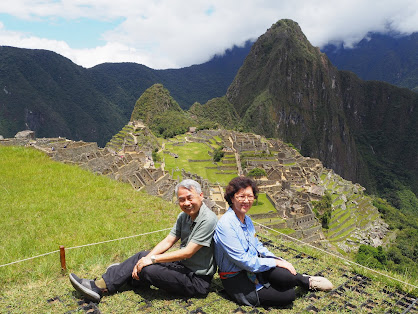We finally made it to Machu Picchu at approx. 10.30am on 17 December 2019. At that moment, we had probably the same feeling as Hiram Bingham when he was led to rediscover this mysterious "Lost City of the Inca" deep in the jungle on top of the mountains in Peru on 24 June 1911. Soon after, serious investigation, study of the ruins and analysis of the relics and artifacts commenced. Two years later and through the National Geographic, Machu Picchu was brought to the attention of the world. Ever since then, its enigma has become the fascination and imagination of many adventurers, trekkers, thrill seekers and travelers just like us. In 1983, this site was declared a UNESCO World Heritage Site. In 2007, it was voted as one of the New Seven Wonders of the World.
Machu Picchu which means "Old Mountain" in Quechua language is reckoned to be built around the 15th century. It was abandoned just 30 years later. This Inca citadel built high in the Andes Mountains above the Urubamba River valley is the tangible evidence of the reign, sophistication and achievement of the Inca Empire.
Machu Picchu which means "Old Mountain" in Quechua language is reckoned to be built around the 15th century. It was abandoned just 30 years later. This Inca citadel built high in the Andes Mountains above the Urubamba River valley is the tangible evidence of the reign, sophistication and achievement of the Inca Empire.
 |
| Machu Picchu as seen on 17 December 2019. |


 |
| An illustration of the original Machu Picchu in the book entitled "Presenting Machu Picchu" by Saydi M Negron Romero. |






14 out of 32 made it to the upper level of the complex.
********************************************
It is still a mystery why this ridge of the mountain was chosen for the construction of a citadel consisting of palaces, temples, plazas and dwelling houses. Certainly, the location is ideal for the elites who wanted a safe haven with year round awesome panoramic view surrounding the hideout! It's surrounded on three sides by Urubamba River at the valley below and sheltered by an imposing peak at the north.


As an engineer, it is the construction of this whole complex that is most remarkable and intriguing. With primitive hand held bronze tools, the builders were able to create ramps and terraces, erect buildings and walls that blend well with the contours of the steep mountainous terrain. The erosion free and stable platforms and terraces with preserved soil that promoted agriculture is testament of the Inca's skill in building and managing surface water drainage, irrigation and water conveyance system.
 |
| An entrance gate to Machu Picchu City. |
 |
| Remnants of the pitched-roof dwelling houses. |


Typical reconstructed pitched roof house.






Equally intriguing is the construction of the sophisticated dry stone walls that fuse huge blocks of stone without the use of mortar. The huge block stones fit so tightly together so well that the cracks cannot be penetrated by a knife blade. This is quite unlike the Great Wall of China in which mortar was used to fuse the bricks together.


**********************************************
Llamas, natives to South America and their cousin, the alpacas are still residents in Machu Picchu. These animals were kept during the Inca Empire for the meat and wool. Today, restaurants in Peru serve llama and alpaca meat. We were also ushered to outlet that markets sweaters, coats, blankets, cardigans and socks made from alpaca wool.




At the Sacred Rock called Wank'a in Quechua in the lower part of Machu Picchu Complex. It's surrounded by a small low wall.


Discover the magic ofCUSCO CITY TOUR 4 HOURSguided tour exploring its ancient Inca heritage and colonial charm. Visit iconic sites like Qorikancha, Sacsayhuamán, and the Cathedral.
ReplyDelete